
Natural Habitat:
- Typically found on plant tissue, decaying wood, and foods
- Soil
- Air outdoors
- Common sabrobe and pathogen of plants
Suitable Substrates in the Indoor Environment:
- Indoors near condensation (window frames, showers)
- House dust (in carpets, and air)
- Also colonizes building supplies, computer disks, cosmetics, leather, optical instruments, paper, sewage, stone monuments, textiles, wood pulp and jet fuel.
Allergic Potential:
- Hay fever
- Hyper sensitivity reactions that can lead to asthma
- In immunocompetent patients, Alternaria colonizes the paranasal sinuses, leading to chronic hypertrophic sinusitis.
Comments:
Alternaria spores are one of the most common and potent indoor and outdoor airborne allergens. Additionally, Alternaria sensitization has been determined to be one of the most important factors in the onset of childhood asthma. Synergy with Cladosporium or Ulocladium may increase the severity of symptoms.

Natural Habitat:
- Decaying plant material
- Soil
Allergic Potential:
- Recognized as an allergen
Suitable Substrates in the Indoor Environment:
- Cellulose containing materials
Comments:
Will grow under same conditions as Stachybotrys, and presence of Arthrinium indicates of good conditions for Stachybotrys growth.

Natural Habitat:
- Everywhere in the nature
Suitable Substrates in the Indoor Environment:
- Frequently found indoors growing on damp substrates
Allergic Potential:
- Depends on genus and species. Considered to be an allergen. Few studies are performed.
Comments:
Ascospores are the result of sexual reproduction and produced in a saclike structure called an ascus. All Ascospores belong to members of the Phylum Ascomycota, which encompasses a plethora of genera worldwide. Ascospores release in the spring are the main source of black spot disease you see on apples, pears and leaves.
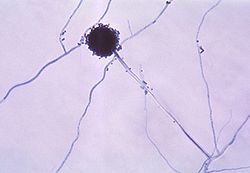
Natural Habitat:
- Soil
- Plant debris
Suitable Substrates in the Indoor Environment:
- Grows on a wide range on substrates indoors
- Prevalent in water damaged buildings
- Some xerophilic species prefer dryer conditions
Allergic Potential:
- Allergic bronchopulmonary aspergillosis (ABPA) which is common in asthmatic and cystic fibrosis patients
- Aspergillus sinusitis
- Invasive aspergillosis in immunocompromised patients
- Hyper sensitivity pneumonitis (inflammation of the lungs)
Comments:
It is the second most common opportunistic pathogen following Candida. Aspergillus is one of the most common fungal genera, worldwide, and Aspergillus fumigatus is one of the most common species found. Can easily be airborne, and humans normally breath in 100-200 spores daily. Can cause disease although most humans are immune to the normal conditions. Ideally you want to have less than 700 Count/m3 in an indoor environment(depending on exterior sampling results).
Natural Habitat:
- Forest floors
- Lawns
- Plants
Suitable Substrates in the Indoor Environment:
- Wood products
- Causing white and brown wood rot, grow and destroy the structural wood of buildings
Allergic Potential:
- Hay fever
- Hyper sensitivity reactions that can lead to asthma
- In immunocompetent patients, Alternaria colonizes the paranasal sinuses, leading to chronic hypertrophic sinusitis.
- Hyper sensitivity pneumonitis (inflammation of the lungs)
- Rarely a pathogen that can cause risk to humans.
Comments:
Basidiospores are the result of sexual reproduction and formed on a structure called the basidium. Basidiospores belong to the members of the Phylum Basidiomycota, which includes mushrooms, shelf fungi, rusts, and Smuts.Commonly found spore, produces microbial volatile organic compounds that give the distictive heavy, musty odor.
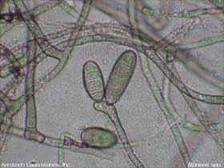
Natural Habitat:
- Plant pathogen of many plants, causing leaf rot, crown rot, and root rot on warm season turf grasses
Suitable Substrates in the Indoor Environment:
- House plants
- Indoor building materials
Allergic Potential:
- Allergic and chronic invasive sinusitis
- Asthma
- Hay fever
Comments:
Grows well on general fungal media although many isolates need “light/dark cycling” for sporulation. Colonies are shades of dark gray to brown.
To people with severe allergies, the spores of this fungus can travel to the sinuses, where they attach to the mucus and grow, producing an allergic reaction that can permanently damages the sinuses. Bipolaris is a potential allergen, and the leading cause of allergic fungal sinusitis.

Natural Habitat:
- Dung
- Seeds
- Soil
- Straw
Suitable Substrates in the Indoor Environment:
- Paper
- Wall paper
- Sheet rock
Allergic Potential:
- Asthma
- Hay fever
Comments:
Grows and sporulates on general fungal media, may need 8-20 days for fruiting body production and sporulation. A very dark and heavy spore that wont remain airborne more than a couple of minutes.
Chaetomium is an indicator spore when it comes to air sampling. Low counts/m3 could be found and could indicate a problem.
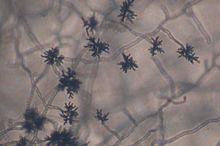
Natural Habitat:
- Dead plant matter
- Soil
- Straw
- Woody plants
Suitable Substrates in the Indoor Environment:
- Fiberglass duct liner
- Paint
- Textiles
- Found in high concentration in water-damaged building materials
Allergic Potential:
- Asthma
- Hay fever
- Hyper sensitivity pneumonitis (inflammation of the lungs)
Comments:
Grows at 0°C, and so is associated with refrigerated foods. Grows on all general fungal media. Some species sporulate better than others, and some may need cycles of light in order to produce spores.
Cladosporium is one of the most common molds found in indoor and outdoor environments, normally outdoor counts are higher than indoor counts. Cladosporium is an indicator spore, and are often found higher indoor than outdoor when other mold types also are higher indoor.
High airborne indoor concentrations could cause health symptoms.
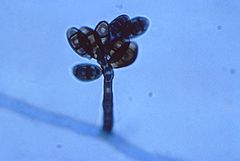
Natural Habitat:
- Plant saprobe and pathogen to cereal plants
- Soil
Suitable Substrates in the Indoor Environment:
- Paper
- Wood products
- Variety of building materials
Allergic Potential:
- Asthma
- Hay fever
- A relatively common cause of allergic fungal sinusitis
Comments:
All Curvularia species are genetically Bipolaris. Grows well on general fungal media; most isolates need “light/dark cycling” for sporulation. Colonies are shades of gray to brown.
Culvaria is potential allergen.
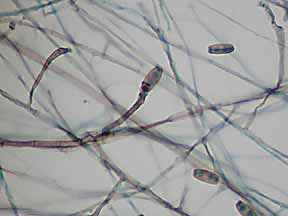
Natural Habitat:
- Plant pathogen causing leaf spot, crown rot, and root rot of various turf grass species
Suitable Substrates in the Indoor Environment:
- Unknown
Allergic Potential:
- Asthma
- Hay fever
- Most commonly reported cause of allergic fungal sinusitis.
Comments:
Group includes Drechslera, Bipolaris, Exserohilum and the rare Helminthosporium. Members of this group can best be differentiated in culture.
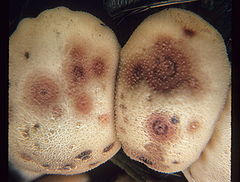
Natural Habitat:
- Plant debris
- Soil
Suitable Substrates in the Indoor Environment:
- Paper
- Textiles
- Allergic Potential
- Asthma
- Hay fever
Comments:
Grows well on general fungal media, although sporulation may be strain dependent. Colonies typically have orange reverse pigment.

Natural Habitat:
- Soil
- Pathogen to Grasses, causes root rot of corn
Suitable Substrates in the Indoor Environment:
- Indoor building materials
Allergic Potential:
- Causes allergic sinusitis
Comments:
Group includes Drechslera, Bipolaris, Exserohilum and the rare Helminthosporium. Members of this group can best be differentiated in culture.
Fibrous particulate are bits of airborne matter that are not arising from any natural growth, and can come from building materials, clothing, textiles, and paper products.
Often airborne as a result of friction applied to any of the mentioned materials.

Natural Habitat:
- Soil
- Plant pathogen causing root rot, stem rot, and wilt of many ornamental and crop plants.
Suitable Substrates in the Indoor Environment:
- Often found in humidifiers
- Wet, cellulose-based building materials
Allergic Potential:
- Asthma
- Hay fever
- Infection in immunocompromised patients
Comments:
Major plant pathogen. Grows well on general fungal media. Sporulation in many species requires specialized media. Colonies are shades of pink to orange to purple. Colors are due to both soluble pigments (observed from the reverse) and mycelial pigments.
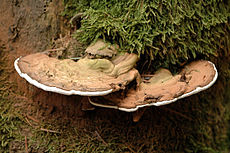
Natural Habitat:
- Grows on conifers and hardwoods worldwide, causing white rot, root rot, and stem rot
Suitable Substrates in the Indoor Environment
- Unknown
Allergic Potential:
- Ganoderma species are known to cause allergies in people on a worldwide scale
Comments:
Used in traditional Chinese medicine as an herbal supplement. It is also known as a shelf fungus because the fruiting body forms a stalk-less shelf on the sides of trees and logs. It is sometimes called artists conk because when you scratch the white pores of the fruiting body, the white rubs away and exposes the brown hyphae underneath. Thus, pictures can be produced on the fruiting body.
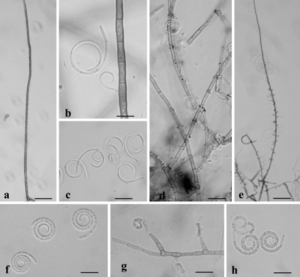
Natural Habitat:
- Found in decaying wood
Suitable Substrates in the Indoor Environment:
- Found in decaying wood
Allergic Potential:
- Considered to be saprophytic. Possible cause of disease is unknown.

Hyphal fragments are components of fungal growth like roots on a tree, and are commonly found in both indoor and outdoor air.
Hyphal fragments are the fruiting body of a fungus, not yet developed to produce and release spores.
The presents of large quantities in indoor environments often indicates an active fungal colony nearby, although itself is rarely a risk to occupants compared to a toxic mold spore, as they usually are too big to be inhaled into the lungs.
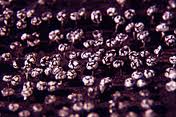
Natural Habitat:
- Decaying logs
- Dead leaves
- Dung
- Lawns
- Mulched flower beds
Suitable Substrates in the Indoor Environment:
- Rotting lumber
- Allergic Potential:
- No report of human infection
Comments:
While a few are distinctive, many of the myxomycete spores are difficult to distinguish from the smuts. These spores are placed in our group “smuts, myxomycetes, Periconia,” due to their similar “round, brown” morphology.

Natural Habitat:
- Common on dead or live grass
- Seeds
- Soil
Suitable Substrates in the Indoor Environment:
- Rarely found growing indoors
Allergic Potential:
- Hay fever
- Asthma
- Very rare report of human infection
Comments:
White, floccose, spreading. Develops black spore clusters with time.
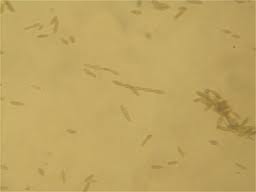
Natural Habitat:
- It is an obligate parasite on many plant varieties causing powdery mildew disease
Suitable Substrates in the Indoor Environment:
- House plants
Allergic Potential:
- No information is available regarding health effects or toxicity. Allergenicity has not been studied

Natural Habitat:
- Soil
- Seed
- Cereal crops
Suitable Substrates in the Indoor Environment:
- Foods (blue mold on cereals, fruits, vegetables, dried foods)
- House dust
- Fabrics
- Leather
- Wallpaper
- Wallpaper glue
- Water damaged building materials
Allergic Potential:
- Hay fever
- Asthma
- Hyper sensitivity pneumonitis (inflammation of the lungs)
Comments:
Grows readily on general fungal media. Colonies are usually shades of blue, green, and white.
Colonies are mostly velvety to powdery in texture. High counts of Penicillium can cause allergic and asthmatic reactions.
Ideally you want to have less than 700 Count/m3 in an indoor environment(depending on exterior sampling results)
![]()
Natural Habitat:
- Grasses
- Sedges
- Rushes
- Dead herbaceous plant material
- Soil
Suitable Substrates in the Indoor Environment:
- Not studied
- Rarely found growing indoors
Allergic Potential:
- Not Studied
Comments:
Generally it is difficult to distinguish Periconia spores from the Smuts, Myxomycetes and other round, brown spore types.

Natural Habitat:
- Obligate pathogen causing Downy Mildew on many types of plants. May be seen on outdoor samples.
Suitable Substrates in the Indoor Environment:
- House plants
Allergic Potential:
- Not studied

Natural Habitat:
- Leaf litter
- Soil
- Tree bark
Suitable Substrates in the Indoor Environment:
- Paper
- Rarely grows indoor
Allergic Potential:
- Not studied
Comments:
Grows readily on general fungal media; sporulation may be slow, and may require a “light/dark cycle.” Colonies are shades of tan to brown. Rarely found growing indoors, but can grow on paper in the right conditions.
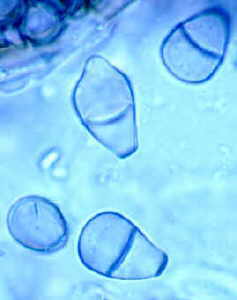
Natural Habitat:
- Leaves
Suitable Substrates in the Indoor Environment:
- Unknown
Allergic Potential:
- Allergenic potential in this genus is not well understood, and is currently being studied.

Natural Habitat:
- Rusts are parasitic to many types of plants
Suitable Substrates in the Indoor Environment:
- Unknown- rust fungi require a living plant host for growth
- Rusts do not grow indoors unless their host plants are present. They are parasitic plant pathogens and need a living host for growth.
Allergic Potential:
- Hay fever
- Asthma
Comments:
There are 5000 known species of rusts belonging to at least 150 different genera. Rusts are the cause of great economic losses on many cultivated plants. Ancient Romans believed the god Robigus was responsible for rust disease on crops and attempted to ward off rust disease by celebrating Robigus in an annual festival.

Natural Habitat:
- Soil
Suitable Substrates in the Indoor Environment:
- Dairy products
- Fruit
- Grain
- Meat
- Paper
- Wood
Allergic Potential:
- Hyper sensitivity pneumonitis (inflammation of the lungs)
- Skin disease
Comments:
Scopulariopsis is a large genus comprising mainly soil species. Species are frequently isolated from food and building materials such as drywall paper and wood. This fungus has relatively high water activity similar to Stachybotrys. Very little is known about the health effects of this fungus. Certain species may be involved in human onychomycoses or pulmonary mycoses. Scopulariopsis has been recovered from culturable air, spore trap, and dust samples. Its Teleomorph, Microascus, has also been recovered from indoor building material. The color can vary from white, brown, or gray/black.

Natural Habitat:
- Pathogens of cereals crops, corn, grasses, onion, and sorghum
Suitable Substrates in the Indoor Environment:
- Unknown- smut fungi require a living plant host for growth
- Smuts do not usually grow indoors. They are parasitic plant pathogens that require a living host for the completion of their life cycle.
Allergic Potential:
- Hay fever
- Asthma
Comments:
Smut fungi belong to the order Ustilaginales and there are about 4000 known species. Smut teliospores cannot easily be distinguished from the myxomycetes and certain species of Periconia. They are reported in the “round, brown” spore category: “Smuts, Periconia, myxomycetes.”

Natural Habitat:
- Plants
- Soils
Suitable Substrates in the Indoor Environment:
- Unknown
Allergic Potential:
- Unknown, poorly studied.

Natural Habitat:
- Decaying plant materials
- Soil
Suitable Substrates in the Indoor Environment:
- Water damaged building materials such as: ceiling tiles, gypsum board, insulation
backing, sheet rock, and wall paper - Paper
- Textiles
Allergic Potential:
- Hay fever
- Asthma
Comments:
Stachybotrys may play a role in the development of sick building syndrome. The presence of this fungus can be significant due to its ability to produce mycotoxins. Exposure to the toxins can occur through inhalation, ingestion, or skin exposure.
Stachybotrys grows well on general fungal media. Stachybotrys is slow growing as compared to Penicillium and other common mold genera, and may not compete well in the presence of other fungi. However, when water availability is high for prolonged periods on environmental material, Stachybotrys may gradually become the predominating mold, especially on cellulose containing materials. Stachybotrys is an indicator spore when it comes to air sampling. Low counts/m3 could be found and could indicate a problem.
Stachybotrys needs ideal conditions to grow. Standing water or a relative humidity of minimum 90% is necessary. When the process first have started, it can continue to grow even if the humidity falls to 60% – 70%. Distribution through the air is possible when the mold dries out or is disturbed. Because of this danger of the airborne dispersion of spores, all cleaning and removal of Stachybotrys should be done using appropriate controls.

Natural Habitat:
- Dead plant material
- Spinach(can cause a leaf spot disease)
- Wood
Suitable Substrates in the Indoor Environment:
- Paper
Allergic Potential:
- Hay fever
- Asthma
- Shares allergens with Alternaria
Comments:
Grows rarely inside, may be seen in indoor dust.

Natural Habitat:
- Leaves
- Plant roots
- Plant litter
- Soil
- Wood
Suitable Substrates in the Indoor Environment
- Baskets
- Paper
- Wicked furniture
- Wood
Allergic Potential:
- Hay fever
- Asthma
Comments:
Some species cause stains in hardwoods. Grows vegetatively on general fungal media but usually requires specialized media for sporulation.

Natural Habitat:
- Plant matters
- Dung, paint, grasses, fibers, wood, decaying plant material, paper, and textiles
Suitable Substrates in the Indoor Environment:
- Gypsum board
- Jute
- Paper rotten wood
- Textiles
- Wood
- Water damaged building material
Allergic Potential:
- Hay fever
- Asthma
- Ulocladium cross-reacts with Alternaria, adding to the allergenic burden of Alternaria-sensitive patients.
Comments:
Grows well on all general fungal media. Colonies are dark brown to rusty brown, granular to velvety. Geniculate sporulating structures can be observed with the stereoscope.
Ulocladium has a high water requirement, and could be found indoors where there is high moisture. Ulocladium is an indicator spore when it comes to air sampling. Low counts/m3 could be found and could indicate a problem.
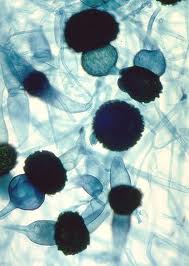
Natural Habitat:
- Decaying plant matter
- Decaying animal matter
Suitable Substrates in the Indoor Environment:
- Fruit
- Vegetables
Allergic Potential:
- Hay fever
- Asthma
- Hypersensitivity
Comments:
Many are extremely fast growing and can inhibit or overgrow other fungi when competing for food or space.
